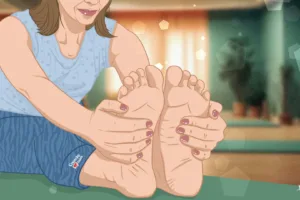Flatten Your Tummy with the Hula Hoop
Looking for an alternative way to tone up your tummy and take inches off your waistline? Then grab your hoop, start spinning and re-connect with your inner child! Yes, that colourful, plastic, circular tube you used in the playground when you were a kid can make miracles: on average, women can burn about 165 calories in 30 minutes of hula hooping.
Popular with celebrities including Beyoncé and Michelle Obama, hula hooping is a great workout that improves your posture, your coordination skills, strength in the abs, obliques, glutes and thighs especially if you’re using a heavy weighted hoop.
According to Edward R. Laskowski from The Mayo Clinic:
Weighted hula hoops can be a good addition to your exercise program, especially if you’re able to hula hoop for at least 10 minutes at a time. In fact, any type of hula hooping, using a weighted hula hoop or a regular hula hoop, can help you meet your exercise goals and provide aerobic activity. And it can be fun!
And If you can manage 30 minutes a day, 3-4 times a week you should notice a dramatic difference in around 4 weeks.
But Hooping is something that takes play and practice. If you have not been moving or dancing much them you need to be patient with your body and give it plenty of time and practice to get used to the movement of hooping.
How to start hooping
There are many ways to learn to hoop: take classes, watch online tutorials, read books about Hooping, attend hoop gatherings. You could also build your own hooping workout: just turn on your favourite playlist to keep you playful and ready to dance. Just remember: where ever the hoop is on your body, that is the part of your body that needs to be pulsing. If there is too much movement below the hoop in your hips and knees the hoop will be drawn down.
You actually need to position your feet hip-width apart, place one slightly in front of the other, tuck your pelvis under, place the hoop around your waist and then after a quick move counter-clockwise you shift your weight forwards and backwards to maintain the hoop’s momentum.
Hulafit gurus suggest giving the hoop a spin and wait for it to rotate around your body a few times before you start pulsing your abdomen backwards and forwards. If it starts to drop down, bend your knees quickly and then straighten up.
When Size Matters
Most importantly you need the right size hula hoop: the bigger the hoop, the easier it is to use because it gives you more time to react to the forward and backward hooping movements. The diameter of the right-sized hoop should be between the height of your waist and your breastbone. For a more intense cardio workout, increase the speed, vary the hoop’s direction, and do alternating knee lifts to challenge your core. Add arm movements and squats to turn the routine into a total body workout.
Hula Hoop Festivals
If you want to learn from the experts, there are plenty of workshops, festivals and events out there.
The Hula Hoop Institute, run by Mishie Hoops (an ambassador for PUMA and Hooper of the Year – Asia 2016), offers free professional hula hoop dance tutorials for complete beginners to support you in starting your hula hooping journey and annual hoop dance retreats in Indonesia, Malaysia and southern Sri Lanka. These gatherings are high-intensity weekends of hoop workshops, crafting, shows, hoop party, ukulele, packed with a lot of laughing. The idea is to provide brand new and experienced hoopers with the opportunity to travel and enjoy a hoop dance retreat experience in exotic stunning locations. Working out together in sized groups for maximum learning, you will meet a community of diverse hoopers and learn more hoop tricks.
If you are not ready for such a commitment, don’t stop hooping and keep an eye on these festivals and special events in the UK:
Unicorn HoopFest 6 April, Bristol
Hulaballoo London 14 April, London
Birmingham Hoop Fest 27 April, Birmingham
Brighton Flow Fest 18 May, Brighton
Funky Facts
Hoops have been used as playthings for centuries, but the hula-hoop was invented in 1958. The toy made from plastic tubing was based on traditional hoops made of rattan or bamboo, and it was wildly popular. At one point, the manufacturer produced 50,000 hula-hoops a day. The word hula was used because the hip movements were seen as similar to the Hawaiian hula dance.




